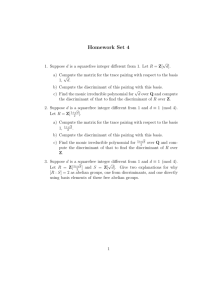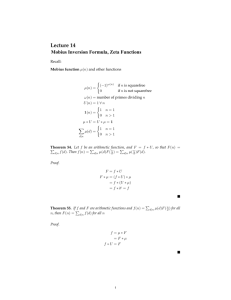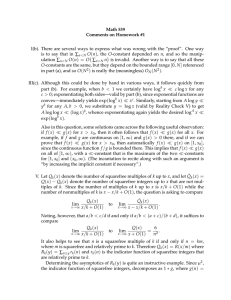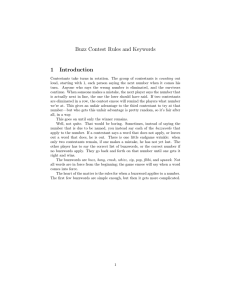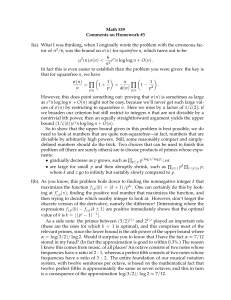Document 11942627
advertisement
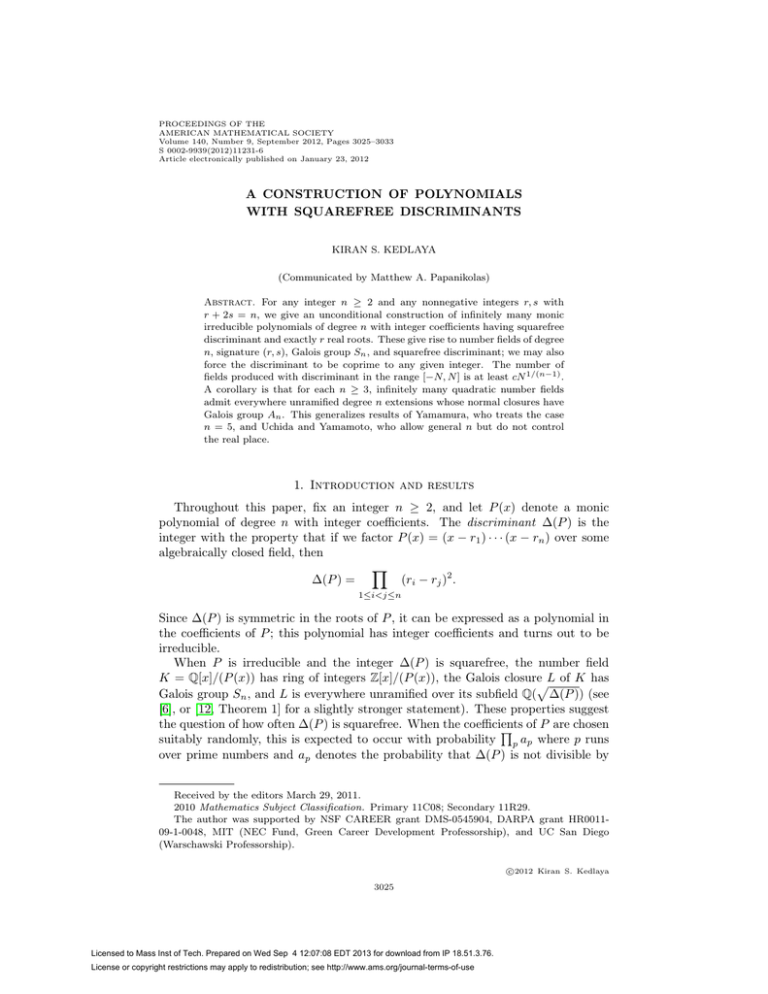
PROCEEDINGS OF THE
AMERICAN MATHEMATICAL SOCIETY
Volume 140, Number 9, September 2012, Pages 3025–3033
S 0002-9939(2012)11231-6
Article electronically published on January 23, 2012
A CONSTRUCTION OF POLYNOMIALS
WITH SQUAREFREE DISCRIMINANTS
KIRAN S. KEDLAYA
(Communicated by Matthew A. Papanikolas)
Abstract. For any integer n ≥ 2 and any nonnegative integers r, s with
r + 2s = n, we give an unconditional construction of infinitely many monic
irreducible polynomials of degree n with integer coefficients having squarefree
discriminant and exactly r real roots. These give rise to number fields of degree
n, signature (r, s), Galois group Sn , and squarefree discriminant; we may also
force the discriminant to be coprime to any given integer. The number of
fields produced with discriminant in the range [−N, N ] is at least cN 1/(n−1) .
A corollary is that for each n ≥ 3, infinitely many quadratic number fields
admit everywhere unramified degree n extensions whose normal closures have
Galois group An . This generalizes results of Yamamura, who treats the case
n = 5, and Uchida and Yamamoto, who allow general n but do not control
the real place.
1. Introduction and results
Throughout this paper, fix an integer n ≥ 2, and let P (x) denote a monic
polynomial of degree n with integer coefficients. The discriminant Δ(P ) is the
integer with the property that if we factor P (x) = (x − r1 ) · · · (x − rn ) over some
algebraically closed field, then
(ri − rj )2 .
Δ(P ) =
1≤i<j≤n
Since Δ(P ) is symmetric in the roots of P , it can be expressed as a polynomial in
the coefficients of P ; this polynomial has integer coefficients and turns out to be
irreducible.
When P is irreducible and the integer Δ(P ) is squarefree, the number field
K = Q[x]/(P (x)) has ring of integers Z[x]/(P (x)), the Galois closureL of K has
Galois group Sn , and L is everywhere unramified over its subfield Q( Δ(P )) (see
[6], or [12, Theorem 1] for a slightly stronger statement). These properties suggest
the question of how often Δ(P ) is squarefree. When the coefficients
of P are chosen
suitably randomly, this is expected to occur with probability p ap where p runs
over prime numbers and ap denotes the probability that Δ(P ) is not divisible by
Received by the editors March 29, 2011.
2010 Mathematics Subject Classification. Primary 11C08; Secondary 11R29.
The author was supported by NSF CAREER grant DMS-0545904, DARPA grant HR001109-1-0048, MIT (NEC Fund, Green Career Development Professorship), and UC San Diego
(Warschawski Professorship).
c
2012
Kiran S. Kedlaya
3025
Licensed to Mass Inst of Tech. Prepared on Wed Sep 4 12:07:08 EDT 2013 for download from IP 18.51.3.76.
License or copyright restrictions may apply to redistribution; see http://www.ams.org/journal-terms-of-use
3026
KIRAN S. KEDLAYA
p2 . These probabilities have been computed by Brakenhoff [1]:
⎧
1
⎪
p = 2, n ≥ 2;
⎪
2,
⎪
⎪
⎨1 − 12 ,
p > 2, n = 2;
p
ap =
2
1
⎪
p > 2, n = 3;
⎪1 − p2 + p3 ,
⎪
⎪
⎩1 − 1 + (p−1)2 (1−(−p)−n+2 ) , p > 2, n ≥ 4.
p2 (p+1)
p
Unfortunately, while it is easy to prove by sieving arguments that a randomly
chosen integer is squarefree with the expected probability of 6/π 2 (see for instance
[9, 18.6]), it seems quite difficult to prove that a polynomial takes squarefree values
with the expected probability unless the degree is very small compared to the
number of variables. For example, for univariate polynomials, this is known in all
degrees under the abc conjecture by a theorem of Granville [7], but unconditionally
only up to degree 3 by work of Hooley [11]. Granville’s conditional theorem was
extended to multivariate polynomials by Poonen [15]; that result implies that under
the abc conjecture, Δ(P ) is squarefree with the expected probability. This remains
true, with a suitably adjusted probability, if one imposes local conditions at finitely
many places (including the infinite place).
However, without assuming any conjectures, it is not trivial to establish even
the existence of infinitely many polynomials of a given degree with squarefree discriminant. This is given by the following theorem.
Theorem 1.1. Let n ≥ 2 be an integer, let r, s be nonnegative integers with r+2s =
n, and let S be a finite set of primes. Then there exist infinitely many monic
irreducible polynomials P (x) of degree n with integer coefficients having exactly r
real roots, such that Δ(P ) is squarefree and not divisible by any of the primes in
S. More precisely, for some c > 0 (depending on n and S), the number of distinct
squarefree discriminants produced in the range [−N, N ] is at least cN 1/(n−1) .
The key idea in the proof is to construct P in a special way to make squarefree
sieving on the discriminant easier. For a1 , . . . , an−1 , b ∈ Q, put
(1.2)
Qa (x) = n(x − a1 /n)(x − a2 ) · · · (x − an−1 ),
x
Pa,b (x) = b +
Qa (t) dt,
0
Δa,b = Δ(Pa,b ).
Then Δa,b is (up to sign) the product of the evaluations of Qa at the roots of Pa,b ,
which is (up to sign) the resultant of Pa,b and Qa . However, one may also compute
the resultant by evaluating Pa,b at each root of Qa :
Δa,b = ±(n Pa,0 (a1 /n) + n b)
n
n
n−1
(Pa,0 (ai ) + b).
i=2
We then choose a1 , . . . , an−1 so that for b of a certain form, the apparent probability
that Pa,b has the desired properties is positive. Since Δa,b factors as a product of
linear polynomials in b, it is tractable to carry out the sieving argument to confirm
that the apparent probability is correct; however, in lieu of doing the sieving by
hand, we appeal to a very general squarefree sieve set up by Helfgott [10]. (The
argument is a bit simpler if one does not insist on the number of real roots; see
Proposition 2.1.)
Licensed to Mass Inst of Tech. Prepared on Wed Sep 4 12:07:08 EDT 2013 for download from IP 18.51.3.76.
License or copyright restrictions may apply to redistribution; see http://www.ams.org/journal-terms-of-use
A CONSTRUCTION OF SQUAREFREE DISCRIMINANTS
3027
From Theorem 1.1, we obtain at once the following corollary.
Corollary 1.3. With notation as in Theorem 1.1, there exist infinitely many number fields K of degree n = r + 2s and signature (r, s) such that the Galois closure L
of K has Galois group Sn over Q and the discriminant of K is squarefree and not
divisible by any of the primes in S. More precisely, for some c > 0 (depending on
n and S), the number of distinct such discriminants produced in the range [−N, N ]
is at least cN 1/(n−1) .
As
noted earlier, these conditions ensure that L is an unramified An -extension
of Q( Δ(K)). We thus obtain the following.
Corollary 1.4. Let S be a finite set of primes. For each n ≥ 3, there exist infinitely
many real quadratic fields unramified above the primes in S and admitting an An extension unramified at all finite and infinite primes. More precisely, for some
c > 0 (depending on n and S), the number of distinct such discriminants produced
in the range [−N, N ] is at least cN 1/(n−1) .
Corollary 1.4 generalizes work of several authors. Uchida [16] and Yamamoto
[17] proved independently that there exist infinitely many real and infinitely many
imaginary quadratic fields with An -extensions unramified at all finite primes. They
did so by constructing number fields of the form Q[x]/(xn + ax + b) and showing
that under suitable conditions on a and b, their normal closures are frequently Sn extensions of Q unramified over a quadratic subfield. However, these number fields
fail to be totally real for n ≥ 4, so the construction does not produce the result of
Corollary 1.4. The case n = 5 of Corollary 1.4 was obtained by Yamamura [18];
however, Yamamura’s construction produces number fields of the form Q[x]/(P (x))
where the polynomial P is of a very special form which does not generalize to higher
degree. (Note that none of the aforementioned constructions guarantee squarefree
discriminants.)
One may also deduce from Corollary 1.3 that the number of Sn -number fields of
signature (r, s) with discriminant in [−N, N ] is bounded below by cN 1/(n−1) . This
is far inferior to what can be shown using other methods: for n ≤ 5 the number
of such fields is known to be O(N ) by work of Bhargava [2, 3], while for larger n,
2
Ellenberg and Venkatesh [5] have given a lower bound of cN 1/2+1/n . However, the
fields we produce have squarefree discriminants and monogenic rings of integers,
which is not guaranteed by these other constructions (although Bhargava’s method
should allow for squarefree sieving; see [4]).
2. Construction of squarefree discriminants
In this section, we give the proof of a weaker form of Theorem 1.1, in which we
do not control the number of real roots. This helps isolate the essential features of
the construction.
Proposition 2.1. Let n ≥ 2 be an integer and let S be a finite set of primes.
Then there exist infinitely many monic irreducible polynomials P (x) of degree n
with integer coefficients such that Δ(P ) is squarefree and not divisible by any of the
primes in S. More precisely, for some c > 0 (depending on n and S), the number
of distinct discriminants produced in the range [−N, N ] is at least cN 1/(n−1) .
The approach to the proof is to consider polynomials Pa,b as in the introduction
with a1 , . . . , an−1 ∈ Z chosen to satisfy the following conditions.
Licensed to Mass Inst of Tech. Prepared on Wed Sep 4 12:07:08 EDT 2013 for download from IP 18.51.3.76.
License or copyright restrictions may apply to redistribution; see http://www.ams.org/journal-terms-of-use
3028
KIRAN S. KEDLAYA
(i) The polynomial Pa,0 has integral coefficients.
(ii) For each p ∈ S, there exists bp ∈ Z such that Δa,bp is not divisible by p.
(iii) For each p ∈
/ S, there exists b ∈ Z such that Δa,b is not divisible by p2 .
(This ensures that Δa,b is squarefree with positive probability.)
/ S and b1 ∈ Z such that Pa,b1 is irreducible modulo p1 ; in
(iv) There exist p1 ∈
particular, Δa,b1 is not divisible by p1 . (This ensures that Pa,b1 is irreducible
for b ≡ b1 (mod p1 ).)
(v) The polynomials nn Pa,0 (a1 /n) + nn b, Pa,0 (a2 ) + b, . . . , Pa,0 (an−1 ) + b in b
are pairwise coprime. (This ensures that Δa,b is squarefree as a polynomial
in b.)
Given such a choice of a1 , . . . , an−1 , let T be the set of all b ∈ Z such that b ≡ bp
(mod p) for each p ∈ S and b ≡ b1 (mod p1 ). For b ∈ T , Pa,b is irreducible with integer coefficients, Δa,b is not divisible by any prime in S, and by a sieving argument
(see Lemma 2.2 below), Δa,b is squarefree with positive probability. Since no value
of Δa,b occurs for more than n − 1 choices of b, by taking b of size O(N 1/(n−1) ), we
obtain at least cN 1/(n−1) squarefree values of Δa,b in the range [−N, N ] for some
fixed c > 0.
The sieving argument required in this argument is essentially no harder than
proving the density of squarefree integers; however, we have nothing to add to
Helfgott’s general presentation of the squarefree sieve, so we defer to it instead.
Lemma 2.2. Let m be a positive integer. Suppose that c1 , d1 , . . . , ck , dk ∈ Z are
such that the polynomial A(x) = (c1 x + d1 ) · · · (ck x + dk ) is squarefree. For p prime,
put
#{x ∈ {0, . . . , p2 − 1} : A(x) ≡ 0 (mod p2 )}
.
a(p) =
p2
Suppose that a(p) > 0 for all p. Then
#{x ∈ {−N, . . . , N } : A(x) is squarefree} =
a(p) > 0.
lim
N →∞
2N + 1
p
Note that p a(p) converges to a positive limit because 1 − k/p2 ≤ a(p) ≤ 1 for
all p not dividing i<j (ci dj − cj di ).
Proof. See [10, Proposition 3.4].
It remains to check that conditions (i)–(v) can be enforced via certain congruence conditions on a1 , . . . , an−1 . To make these congruences compatible with the
requirement that the derivative of Pa,b have only rational roots, we need some
auxiliary calculations.
Lemma 2.3. Let p0 be a prime not dividing n(n − 1). Then there exist infinitely
x + p0 is irreducible
many primes p1 modulo which the polynomial R(x) = xn − pn−1
0
splits
into
distinct
linear
factors.
and its derivative R (x) = nxn−1 − pn−1
0
Proof. The polynomial R has splitting field L = Q(ζn−1 , n1/(n−1) ), in which p0
does not ramify because p0 does not divide n(n − 1). Thus R is an Eisenstein
polynomial with respect to any prime above p0 in L; in particular, R is irreducible
over L. By the Chebotarev density theorem, there exist infinitely many prime
ideals of L of absolute degree 1 modulo which R is irreducible; the norm of any
such prime ideal is a prime number of the desired form.
Licensed to Mass Inst of Tech. Prepared on Wed Sep 4 12:07:08 EDT 2013 for download from IP 18.51.3.76.
License or copyright restrictions may apply to redistribution; see http://www.ams.org/journal-terms-of-use
A CONSTRUCTION OF SQUAREFREE DISCRIMINANTS
3029
Lemma 2.4. For any field F of characteristic zero, there exist a1 , . . . , an−1 ∈ F
such that the values Pa,0 (a1 /n), Pa,0 (a2 ), . . . , Pa,0 (an−1 ) are pairwise distinct.
Proof. For a1 , . . . , an−1 ∈ Q with a1 < · · · < an−1 ,
an−2
(t − a1 /n)(t − a2 ) · · · (t − an−1 ) dt = 0
Pa,0 (an−1 ) − Pa,0 (an−2 ) =
an−1
because the integrand has constant sign over the interval. Consequently, the polynomial Pa,0 (an−1 ) − Pa,0 (an−2 ) in a1 , . . . , an−1 is nonzero. By similar reasoning,
each of the factors of the polynomial
n−1
i=2
2≤i<j≤n−1
(Pa,0 (ai ) − Pa,0 (a1 /n))
(Pa,0 (aj ) − Pa,0 (ai ))
in a1 , . . . , an−1 is not zero, so the product is not the zero polynomial either. Since
F is infinite, the claim follows.
We are now ready to complete the proof of Proposition 2.1.
Proof of Proposition 2.1. By the previous discussion, it is sufficient to exhibit
a1 , . . . , an−1 ∈ Z for which conditions (i)–(v) hold. Choose p0 , R, p1 as in Lemma 2.3, making sure that p1 ∈
/ S ∪ {1, . . . , n}. Apply Lemma 2.4 to choose
a1 , . . . , an−1 ∈ Q for which
(2.5)
Pa ,0 (a1 /n), Pa ,0 (a2 ), . . . , Pa ,0 (an−1 )
/ S ∪ {1, . . . , n, p1 } for
are pairwise distinct. We can then choose a prime p2 ∈
which the values in (2.5) have well-defined and distinct reductions modulo p2 . We
now choose a1 , . . . , an−1 according to the following conditions (which is evidently
possible).
(a) The integer a1 is coprime to n and is divisible by n − 1 and by all primes
of S not dividing n. The integers a2 , . . . , an−1 are divisible by n! and by
all primes in S.
(b) The quantities a1 /n, a2 , . . . , an−1 are congruent modulo p1 to the roots of
R (x) (in some order).
(c) We have ai ≡ ai (mod p2 ) for i = 1, . . . , n − 1.
We then have
Qa (x) ≡ (nx − a1 )xn−2 = nxn−1 − a1 xn−2 (mod n!),
so the coefficient of xm−1 in Qa (x) is divisible by m for m = 1, . . . , n. Consequently,
Pa,0 has integer coefficients. This verifies (i). Suppose next that p is a prime which
either belongs to S or is at most n. For b ∈ Z, Pa,0 (ai ) + b ≡ b (mod p) for
i = 2, . . . , n − 1, while
an1 (mod p)
if p divides n,
n
n
n Pa,0 (a1 /n) + n b ≡
n
n b (mod p) otherwise.
Consequently, Δa,1 is not divisible by p; this verifies (ii), as well as (iii) for primes
p ≤ n. For p > n not in S, there are at least p − n + 1 choices of b ∈ {0, . . . , p − 1}
for which Δa,b is not even divisible by p, since each linear factor of Δa,b rules out
exactly one choice of b. This verifies (iii). Since (b) implies (iv) and (c) implies (v),
the needed conditions are enforced, so the proof described above goes through. Licensed to Mass Inst of Tech. Prepared on Wed Sep 4 12:07:08 EDT 2013 for download from IP 18.51.3.76.
License or copyright restrictions may apply to redistribution; see http://www.ams.org/journal-terms-of-use
3030
KIRAN S. KEDLAYA
3. Controlling real roots
Note that the proof of Proposition 2.1 cannot be used to deduce Theorem 1.1
because it does not allow any control of the number of real roots of the polynomial
Pa,b . Indeed, the function Pa,0 (x) is monotonic for x large and for x small, so Pa,b
has at most 2 real roots for |b| sufficiently large. To obtain Theorem 1.1, we must
modify the proof of Proposition 2.1 so that b can be chosen to be a rational number
within a suitable interval.
Proof of Theorem 1.1. Define p0 , R, p1 , p2 , a1 , . . . , an−1 as in the proof of Proposition 2.1. Let U be the set of A = (A1 , . . . , An−1 ) ∈ Rn−1 for which there exists
B ∈ R such that the polynomial PA,B has exactly r real roots; the set U is easily
seen to be open and nonempty. It is also homogeneous: if (A1 , . . . , An−1 ) belongs
to U , then so does (λA1 , . . . , λAn−1 ) for any λ ∈ R. In other words, U is the
inverse image in Rn−1 of a nonempty open subset of the (n − 2)-dimensional projective space over R. In that space, the images of the tuples consisting of integers
satisfying conditions (a)–(c) of the proof of Proposition 2.1 form a dense subset; we
may thus choose (A1 , . . . , An−1 ) ∈ U satisfying these conditions. Fix such a choice
hereafter; there then exists a nonempty interval I such that PA,B has exactly r real
roots for all B ∈ I.
We wish to take ai = Aq for some positive integer q ≡ 1 (mod n!p1 p2 p∈S p).
These still satisfy conditions (a)–(c) of the proof of Proposition 2.1, so conditions
(i)–(v) are enforced. We may then sieve again (see Lemma 3.1) to show that
among b of this form congruent to bp modulo p for each p ∈ S and congruent to
b1 modulo p1 , those for which Δa,b is squarefree occur with positive probability.
Since the map b → Δa,b is at most (n − 1)-to-one, if we consider all q ≤ N 1/(n−1) ,
the number of squarefree discriminants obtained is at least 1/(n − 1) times the
maximum number of squarefree values of Δa,b achieved for any single choice of q in
this range. This yields a lower bound of cN 1/(n−1) discriminants of absolute value
at most N , proving Theorem 1.1.
In this case, the sieving argument needed is an easy (because we only consider
polynomials composed of linear factors) variant of the squarefree sieving for homogeneous binary forms introduced by Greaves [8]. However, we again prefer to apply
Helfgott’s machine rather than get into the details.
Lemma 3.1. Let k, n, t be positive integers, and let I be a nonempty open interval.
Suppose that c1 , d1 , . . . , ck , dk ∈ Z are such that the polynomial A(x, y) = (c1 x +
d1 y) · · · (ck x + dk y) is squarefree. For p prime, if p divides t, then put
a(p) =
#{x ∈ {0, . . . , p2 − 1} : A(x, 1) ≡ 0 (mod p2 )}
;
p2
otherwise, put
a(p) =
#{(x, y) ∈ {0, . . . , p2 − 1}2 : gcd(x, y) = 1, A(x, y n ) ≡ 0 (mod p2 )}
.
p2 (p − 1)2
Suppose that a(p) > 0 for all p. Define
SN = {(x, y) ∈ Z2 : 1 ≤ y ≤ N, y ≡ 1 (mod t), gcd(x, y) = 1, x/y n ∈ I}.
Licensed to Mass Inst of Tech. Prepared on Wed Sep 4 12:07:08 EDT 2013 for download from IP 18.51.3.76.
License or copyright restrictions may apply to redistribution; see http://www.ams.org/journal-terms-of-use
A CONSTRUCTION OF SQUAREFREE DISCRIMINANTS
Then
3031
#{(x, y) ∈ SN : A(x, y n ) is squarefree} =
ap > 0.
N →∞
#SN
p
lim
Proof. This follows from [10, Corollary 3.3] modulo matching up notation, which
we now explain (following the model of [10, Proposition 3.5]). We define a soil in
the sense of [10, §3.2] by taking
P = {primes in Z},
r(x, y) = {p ∈ P : p2 |A(x, y n )},
A = SN ,
f (x, y, d) =
1 d = ∅,
0 otherwise.
Put X = #SN ; note that X is asymptotic to a constant times N n+1 as N → ∞.
For d ⊂ P finite, write h(d) for p∈d p2 ; this function evidently satisfies conditions
(h1) and (h2) of [10, §3.2]. Let K(d) be the number of (x, y) ∈ A with d ⊆ r(x, y);
since there are only finitely many primes that can divide more than one factor of
A(x, y n ), we have K(d) ≤ C0 X/h(d) for some C0 > 0 (dependent on everything but
N and d). This means that condition (A1) of [10, §3.2] holds with C1 = 1, C2 = 0.
For d with h(d) ≤ N 1/4 , put g(d, ∅) = h(d) p∈d a(p); we may then write
K(d) = X
g(d, ∅)
+ rd,∅
h(d)
with |rd,∅ | ≤ N h(d) ≤ N 5/4 . (Namely, for each y, we are counting values of x
in an interval satisfying certain congruence conditions modulo h(d); the difference
between this count and the expected value is at most 1 in each congruence class.)
By [10, Corollary 3.3], the difference
#{(x, y) ∈ SN : A(x, y n ) is squarefree}
ap −
X
p
is bounded in absolute value by
3#d
C1
+ X −1
h(d)
1/4
d:h(d)>N
|rd,∅ | + X −1 C2
d:h(d)≤N 1/4
X
p2
p>N
for some C1 , C2 > 0 independent of N . The first and third terms evidently tend to
0 as N → ∞; the second does also because it is bounded above by X −1 N 1/4 N 5/4 ≤
C3 N −n+1/2 for some C3 > 0 independent of N . This proves the claim.
4. Further remarks
We have not attempted to improve upon the lower bound of cN 1/(n−1) in Theorem 1.1 or its corollaries. Nakagawa [13], [14] attempted to show that the number
of real quadratic fields admitting An -extensions unramified at all finite primes with
discriminants in [−N, N ] is at least cn N (n+1)/(2n−2) for all n, but these proofs were
later retracted. This order of growth would be obtained if one could show that the
discriminant of an arbitrary (not necessarily monic) integer polynomial of degree n
is squarefree with positive probability and that the number of distinct discriminants
obtained is at least a fixed positive fraction of the number of polynomials considered. Even if one assumes the abc conjecture, so that the first issue is resolved by
Poonen’s theorem, the second issue remains: for any construction of polynomials
Licensed to Mass Inst of Tech. Prepared on Wed Sep 4 12:07:08 EDT 2013 for download from IP 18.51.3.76.
License or copyright restrictions may apply to redistribution; see http://www.ams.org/journal-terms-of-use
3032
KIRAN S. KEDLAYA
involving more than one free parameter, it is nontrivial to ensure that the same
discriminant does not occur too many times.
It would also be of interest to extend our results by allowing restrictions on
the splitting of some finite places. Our method is unsuitable for this purpose: a
splitting requirement would constitute an additional restriction on the reduction of
a polynomial modulo specific primes, which is hard to integrate with the requirement that the derivative of the polynomial have rational roots modulo any prime.
Indeed, for primes less than n, certain splitting requirements on the polynomial
alone (e.g., that it factors completely) are incompatible with having a squarefree
discriminant, because there are not enough residual roots available for them to be
pairwise distinct.
Acknowledgments
This paper is a revised version of our unpublished 2003 preprint “Number fields
with squarefree discriminant and prescribed signature”, written while the author
was supported by an NSF Postdoctoral Fellowship. The revisions were made during
the spring 2010 MSRI program in arithmetic statistics. The author thanks Manjul
Bhargava, Chandan Singh Dalawat, Noam Elkies, and Harald Helfgott for helpful
discussions and especially Manju Bhargava for encouraging the author to revisit
the 2003 manuscript.
References
[1] A. Ash, J. Brakenhoff, and T. Zarrabi, Equality of polynomial and field discriminants, Exper.
Math. 16 (2007), 367–374. MR2367325 (2008i:11129)
[2] M. Bhargava, The density of discriminants of quartic rings and fields, Ann. of Math. (2) 162
(2005), 1031–1063. MR2183288 (2006m:11163)
[3] M. Bhargava, The density of discriminants of quintic rings and fields, Ann. of Math. (2) 172
(2010), 1559–1591. MR2745272
[4] M. Bhargava, The geometric squarefree sieve and unramified nonabelian extensions of quadratic fields, preprint (2011).
[5] J.S. Ellenberg and A. Venkatesh, The number of extensions of a number field with fixed
degree and bounded discriminant, Ann. of Math. (2) 163 (2006), 723–741. MR2199231
(2006j:11159)
[6] J. Elstrodt, F. Grunewald, and J. Mennicke, On unramified Am -extensions of quadratic
number fields, Glasgow Math. J. 27 (1985), 31–37. MR819826 (87e:11122)
[7] A. Granville, ABC allows us to count squarefrees, Intl. Math. Res. Notices 1998, 991–1009.
MR1654759 (99j:11104)
[8] G. Greaves, Power-free values of binary forms, Quart. J. Math. Oxford 43 (1992), 45–65.
MR1150469 (92m:11098)
[9] G.H. Hardy and E.M. Wright, An Introduction to the Theory of Numbers, fourth edition,
Oxford University Press (London), 1965.
[10] H.A. Helfgott, On the square-free sieve, Acta Arith. 115 (2004), 349–402. MR2099831
(2005h:11211)
[11] C. Hooley, On the power free values of polynomials, Mathematika 14 (1967), 21–26.
MR0214556 (35:5405)
[12] T. Kondo, Algebraic number fields with the discriminant equal to that of a quadratic number
field, J. Math. Soc. Japan 47 (1995), 31–36. MR1304187 (95h:11121)
[13] J. Nakagawa, Binary forms and orders of algebraic number fields, Invent. Math. 97 (1989),
219–235; erratum, Invent. Math. 105 (1991), 443. MR1001839 (90k:11042)
[14] J. Nakagawa, Binary forms and unramified An -extensions of quadratic fields, J. Reine Angew.
Math. 406 (1990), 167–178; correction, J. Reine Angew. Math. 413 (1991), 220. MR1048239
(91d:11037); MR1089804 (91j:11019)
Licensed to Mass Inst of Tech. Prepared on Wed Sep 4 12:07:08 EDT 2013 for download from IP 18.51.3.76.
License or copyright restrictions may apply to redistribution; see http://www.ams.org/journal-terms-of-use
A CONSTRUCTION OF SQUAREFREE DISCRIMINANTS
3033
[15] B. Poonen, Squarefree values of multivariate polynomials, Duke Math. J. 118 (2003), 353–
373. MR1980998 (2004d:11094)
[16] K. Uchida, Unramified extensions of quadratic number fields, II, Tôhoku Math. J. 22 (1970),
220–224. MR0272760 (42:7641)
[17] Y. Yamamoto, On unramified Galois extensions of quadratic number fields, Osaka J. Math.
7 (1970), 57–76. MR0266898 (42:1800)
[18] K. Yamamura, On unramified Galois extensions of real quadratic number fields, Osaka J.
Math. 23 (1986), 471–478. MR856901 (88a:11112)
Department of Mathematics, Massachusetts Institute of Technology, 77 Massachusetts Avenue, Cambridge, Massachusetts 02139 – and – Department of Mathematics,
University of California, San Diego, 9500 Gilman Drive #0112, La Jolla, California
92093
E-mail address: kedlaya@mit.edu
E-mail address: kedlaya@ucsd.edu
Licensed to Mass Inst of Tech. Prepared on Wed Sep 4 12:07:08 EDT 2013 for download from IP 18.51.3.76.
License or copyright restrictions may apply to redistribution; see http://www.ams.org/journal-terms-of-use

